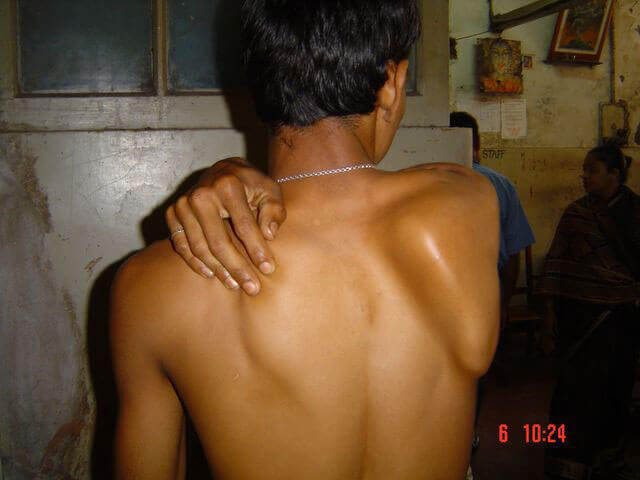Backpack Palsy – the Compression of the Long Thoracic Nerve
 We all know that wearing a backpack for an extended period can be painful but few of us realise that, in admittedly rare cases, a badly fitted pack can have real consequences. A backpack typically rests on our shoulders, with smaller schoolbag sized packs distributing the weight on to the upper trapezius muscles and larger trekking style backpacks using straps to pull tightly around the chest for stability while the weight is transferred to the pelvis via a sacral pad.
We all know that wearing a backpack for an extended period can be painful but few of us realise that, in admittedly rare cases, a badly fitted pack can have real consequences. A backpack typically rests on our shoulders, with smaller schoolbag sized packs distributing the weight on to the upper trapezius muscles and larger trekking style backpacks using straps to pull tightly around the chest for stability while the weight is transferred to the pelvis via a sacral pad.
For adults it is always advisable to use a trekking style pack for heavier loads, think anything above 15kg, so that the weight is taken by the hips. A school bag should be sufficient for most school sized loads though the weight of text books, laptops, instruments and sports gear can be challenging to carry at some schools. Careful thought should be given as to what is required in each days load out.
What Is Backpack Palsy?
Backpack palsy occurs very rarely, but it is a paralysis of the serratus anterior muscle. This muscle extends from the rib cage to the bottom tip of the shoulder blade and keeps the shoulder blade sitting flush against the rib cage. The resulting paralysis and loss of function of the serratus anterior muscle gives us the classic “winged appearance” of backpack palsy as shown in the image below.
This type of paralysis can occur when a backpack overloads our shoulder girdle, causing the shoulder blades to sag down dragging the collarbones with them. The collarbones will then compress the delicate long thoracic nerve against our rib cage and it is this nerve compression which causes the paralysis. It may be accompanied by some pain in the shoulder and may make it difficult for the sufferer to raise their arm above shoulder height but the most prominent sign of backpack palsy is the winging of the shoulder blade.

Interestingly backpack palsy is more common in soldiers than the general population and the Korean army has found that, amongst new recruits, men with lower body mass were more likely to develop a backpack palsy! Presumably a lower body mass correlates with lower muscle mass and these people are less resistant to the drag their loaded packs put on them.
Causes of Backpack Palsy
Several factors contribute to the development of backpack palsy:
Heavy Backpacks: Carrying a backpack that exceeds a reasonable weight relative to one’s body size can place undue stress on the shoulders and neck.
Poor Backpack Ergonomics: Wearing a backpack too low, unevenly distributed, or with inadequate padding can lead to compression and strain on the brachial plexus.
Prolonged Carrying: Carrying a heavy backpack for extended periods, such as during long school days or while traveling, increases the risk of developing backpack palsy.
How Your Local Paddington Chiropractors Can Help
Chiropractors are well-equipped to diagnose and treat backpack palsy effectively. We offer a holistic approach to care that may include the following:
Assessment: Chiropractors will conduct a thorough examination to understand the extent of the nerve compression and its impact on your musculoskeletal system.
Spinal Adjustments: Chiropractic adjustments can help alleviate nerve compression by realigning the spine, reducing tension, and promoting the body’s natural healing processes.
Postural Education: Chiropractors can educate patients on proper backpack ergonomics, as well as provide guidance on maintaining good posture.
Exercises and Rehabilitation: Chiropractors may recommend specific exercises to strengthen the affected muscles and improve overall posture.
Lifestyle Recommendations: Chiropractors can advise on lifestyle modifications, such as weight management and stress reduction, to prevent a recurrence of backpack palsy.
Recovery Time and Treatment
How long function takes to return might vary and there are different treatment approaches available. A surgeon may be able to harvest a small piece of ligament to fix the shoulder blade back against the rib cage so it never moves upwards again however chiropractic care is usually required after surgery.
The other treatment option is to go straight to a chiropractor who will generally be able to exercise the muscle back to normalcy over a period of about 8 weeks. In both cases however full recovery will likely take 6 – 12 months and this time period will depend on the degree of initial nerve damage.
If you are experiencing pain around your spine and you are unsure what is causing it, book an appointment to see one of our Paddington chiropractors. We will be able to assess your body and provide suggestions and treatment.

Hi, I’m Michael; Chiropractor, Dad, science enthusiast, active weightlifter and keen sportsman. I work with busy and active people who are struggling with pain to find relief from their symptoms so that they can return to an active lifestyle, get through their work day and their workouts without having to pop a pill so that they can feel happier and healthier in their body.

